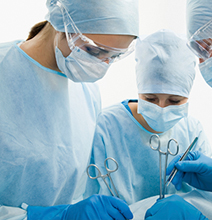Types of reconstruction
RECONSTRUCTION WITH IMPLANTS
Permanent prosthesis and tissue expanders
Implants are the best option for women with small or medium size breasts, and those who did not have radiotherapy on the thoracic area. In these cases the pectoral muscle is used to create a pocket where the implant is inserted.
Implants come in many shapes and sizes, filled with sterile salt water (saline) or silicone gel.
Your plastic surgeon will help you to determine which implant suits you best.
If there is not enough skin to fit an implant, a tissue expander is first inserted in the skin pocket. This is an inflatable bag with saline that in the next few months will be slowly filled with more saline to gradually stretch the skin and the muscle.
Once the right size is achieved, the expander is removed and replaced by a permanent implant.
RECONSTRUTION WITH TISSUE TRANSPLANT
Another method of breast reconstruction is using tissues from other parts of the body. This is called a flap reconstruction. A flap is similar to a graft - in the sense that it is a transfer of tissues including skin, fat, etc.– except that a flap also carries its own blood vessels/supply.
The new breast can be built using muscle from the abdomen (called a DIEP flap), or from the upper part of your back (TRAM flap).
An oval section of skin, fat and muscle is removed from one of these locations, and shaped like a breast on the thoracic wall.
The correct reconstruction depends on skin available on the thoracic wall, size and shape of the other breast, tissues available for the flap, the patient's body fat and health history- including obesity and smoking, which are known to increase reconstruction complications- and, of course, on the patient's preferences.
BREAST PROSTHESES
Women, who do not want breast reconstruction, can choose silicone breast prostheses to attain symmetry. These have distinct textures – hard, medium or soft – as well as different shapes, sizes and skin tones to look like the other breast. The prosthesis is put into a special pocket inside the bra or swimming suit. It needs to be properly adjusted and weighted to help with a correct posture.
When buying prosthesis, ask your doctor or nurse for information about where to find them – some hospitals even have their own shops.



